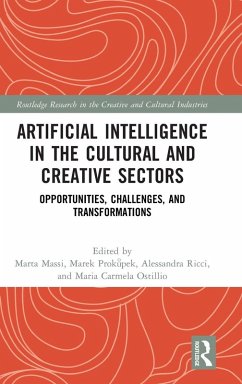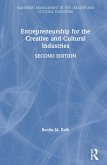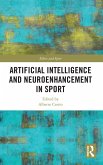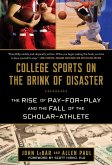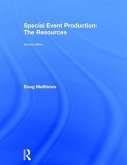Artificial Intelligence in the Cultural and Creative Sectors
Opportunities, Challenges, and Transformations
Herausgeber: Ricci, Alessandra; Massi, Marta; Ostillio, Maria Carmela; Prokupek, Marek
Artificial Intelligence in the Cultural and Creative Sectors
Opportunities, Challenges, and Transformations
Herausgeber: Ricci, Alessandra; Massi, Marta; Ostillio, Maria Carmela; Prokupek, Marek
- Gebundenes Buch
- Merkliste
- Auf die Merkliste
- Bewerten Bewerten
- Teilen
- Produkt teilen
- Produkterinnerung
- Produkterinnerung
Spanning areas such as publishing, heritage, music, performance, and design, the book offers the first comprehensive, interdisciplinary examination of AI's impact across these diverse sectors as technologies become increasingly embedded in both creative and operational processes.
Andere Kunden interessierten sich auch für
![Entrepreneurship for the Creative and Cultural Industries Entrepreneurship for the Creative and Cultural Industries]() Bonita M KolbEntrepreneurship for the Creative and Cultural Industries214,99 €
Bonita M KolbEntrepreneurship for the Creative and Cultural Industries214,99 €![Artificial Intelligence and Neuroenhancement in Sport Artificial Intelligence and Neuroenhancement in Sport]() Artificial Intelligence and Neuroenhancement in Sport179,99 €
Artificial Intelligence and Neuroenhancement in Sport179,99 €![A Treatise on Archery or the Art of Shooting With the Long Bow A Treatise on Archery or the Art of Shooting With the Long Bow]() Thomas WaringA Treatise on Archery or the Art of Shooting With the Long Bow28,99 €
Thomas WaringA Treatise on Archery or the Art of Shooting With the Long Bow28,99 €![Floating Flies And How To Dress Them - A Treatise On The Most Modern Methods Of Dressing Artificial Flies For Trout And Grayling - With Full Illustrated Directions And Containing Ninety Hand-Coloured Engravings Of The Most Killing Patterns Floating Flies And How To Dress Them - A Treatise On The Most Modern Methods Of Dressing Artificial Flies For Trout And Grayling - With Full Illustrated Directions And Containing Ninety Hand-Coloured Engravings Of The Most Killing Patterns]() Frederic Michael HalfordFloating Flies And How To Dress Them - A Treatise On The Most Modern Methods Of Dressing Artificial Flies For Trout And Grayling - With Full Illustrated Directions And Containing Ninety Hand-Coloured Engravings Of The Most Killing Patterns30,99 €
Frederic Michael HalfordFloating Flies And How To Dress Them - A Treatise On The Most Modern Methods Of Dressing Artificial Flies For Trout And Grayling - With Full Illustrated Directions And Containing Ninety Hand-Coloured Engravings Of The Most Killing Patterns30,99 €![College Sports on the Brink of Disaster College Sports on the Brink of Disaster]() John LebarCollege Sports on the Brink of Disaster20,99 €
John LebarCollege Sports on the Brink of Disaster20,99 €![Special Event Production: The Resources Special Event Production: The Resources]() Doug MatthewsSpecial Event Production: The Resources214,99 €
Doug MatthewsSpecial Event Production: The Resources214,99 €![The Olympic Games and Cultural Policy The Olympic Games and Cultural Policy]() Beatriz GarciaThe Olympic Games and Cultural Policy178,99 €
Beatriz GarciaThe Olympic Games and Cultural Policy178,99 €-
-
-
Spanning areas such as publishing, heritage, music, performance, and design, the book offers the first comprehensive, interdisciplinary examination of AI's impact across these diverse sectors as technologies become increasingly embedded in both creative and operational processes.
Produktdetails
- Produktdetails
- Verlag: Taylor & Francis Ltd
- Seitenzahl: 278
- Erscheinungstermin: 13. November 2025
- Englisch
- Abmessung: 234mm x 156mm
- Gewicht: 720g
- ISBN-13: 9781032835204
- ISBN-10: 1032835206
- Artikelnr.: 74434298
- Herstellerkennzeichnung
- Libri GmbH
- Europaallee 1
- 36244 Bad Hersfeld
- gpsr@libri.de
- Verlag: Taylor & Francis Ltd
- Seitenzahl: 278
- Erscheinungstermin: 13. November 2025
- Englisch
- Abmessung: 234mm x 156mm
- Gewicht: 720g
- ISBN-13: 9781032835204
- ISBN-10: 1032835206
- Artikelnr.: 74434298
- Herstellerkennzeichnung
- Libri GmbH
- Europaallee 1
- 36244 Bad Hersfeld
- gpsr@libri.de
Marta Massi, PhD, is an Assistant Professor at Athabasca University, Canada. She previously held positions as Assistant Professor at Università Cattolica del Sacro Cuore and Trent University, and as Lecturer at McGill University. Her research focuses on consumer behavior, arts marketing, and branding. Her work has been published in leading journals such as Psychology & Marketing, International Journal of Market Research, Journal of Strategic Marketing, and Journal of Business & Industrial Marketing. Most recently, she edited the Routledge volume Digital Transformation in the Cultural and Creative Industries: Production, Consumption and Entrepreneurship in the Digital Economy and Sharing. Marek Prok¿pek is an Associate Professor in Arts Management at KEDGE Arts School at KEDGE Business School in France, where he is also a member of the Creative Industries & Culture Research Centre. His research interests lie primarily in the areas of innovative business models of arts and cultural organizations, museum fundraising and philanthropy and its ethical challenges, and the art market. Alessandra Ricci is Fellow of Marketing Management at SDA Bocconi School of Management. She has previously worked as a postdoctoral research fellow at IULM University, Milan, and held teaching and research positions at Bocconi University, the University of Gastronomic Sciences in Pollenzo, and the Catholic University of the Sacred Heart of Milan. Her research focuses on the high-end sector-including artisanship, luxury, and Made-in-Italy-through the lenses of marketing, sustainability, and value creation. She also has professional expertise in cultural heritage management and tourism. Maria Carmela Ostillio is an Associate Professor of Marketing and Sales at SDA Bocconi. She directs the Brand Academy and has led research projects in branding, marketing, and corporate communications. Her expertise includes brand management, direct marketing, and marketing information systems.
Foreword: Artificial Intelligence and Creativity
Chapter 1: Introduction to Artificial Intelligence in the Cultural and
Creative Sectors
Chapter 2: The Voyager, the Mirror, and the Creative Act. Three Metaphors
for Understanding Generative Artificial Intelligence.
Chapter 3: Artists in the Age of AI - A Typology of Human-Machine
Collaborations and Associated Imaginaries.
Chapter 4: Breathing Life into AI - Querying AI through Tactile Imprints
Using Breath and Sound.
Chapter 5: The Rise of "Alone Teamwork": Unveiling the Transformations in
the Creation Process of Artists Using Generative Artificial Intelligence
Tools.
Chapter 6: Imagination and AI: A Socio-Technical Reading of Artists as
Agents of Innovation in AI Development.
Chapter 7: Reviving Textile Heritage: AI-Driven Innovation Practices in
Museum Exhibitions.
Chapter 8: Contemporary Art and Biodiversity: The Impact of Artificial
Intelligence on Art Museum Collections.
Chapter 9: Mediation and Artificial Intelligence: Transdisciplinary
collaboration in the AI.MAGINATION Exhibition.
Chapter 10: Navigating AI in Museums: Overcoming Barriers and Implementing
Strategic Solutions.
Chapter 11: Augmenting the Stage: The Intersection Between AI and Theatre.
Chapter 12: Creating Stories with Generative AI in Film Education - The
Screenwriters' Room with Large Language Models (LLMs).
Chapter 13: Developing a Value Chain for Personalised Children's Book with
Support of Artificial Intelligence.
Chapter 14: Is This Really Disruption? An Organisational Perspective about
AI in the Book Industry.
Chapter 15: Unleashing Creativity: The Powerful Duo of Artificial
Intelligence and Brand Heritage.
Chapter 16: Redefining Luxury in the Age of Generative AI: Navigating
Innovation and Heritage in Brand Management.
Chapter 17: How Young Adults Perceive the Prevalence of Metahuman Artists.
Chapter 18: The Adoption of Generative Ai in Video Game Production: Firm
and Industry-Level Dynamics.
Afterword: Artificial Intelligence in Cultural and Creative Sectors
Chapter 1: Introduction to Artificial Intelligence in the Cultural and
Creative Sectors
Chapter 2: The Voyager, the Mirror, and the Creative Act. Three Metaphors
for Understanding Generative Artificial Intelligence.
Chapter 3: Artists in the Age of AI - A Typology of Human-Machine
Collaborations and Associated Imaginaries.
Chapter 4: Breathing Life into AI - Querying AI through Tactile Imprints
Using Breath and Sound.
Chapter 5: The Rise of "Alone Teamwork": Unveiling the Transformations in
the Creation Process of Artists Using Generative Artificial Intelligence
Tools.
Chapter 6: Imagination and AI: A Socio-Technical Reading of Artists as
Agents of Innovation in AI Development.
Chapter 7: Reviving Textile Heritage: AI-Driven Innovation Practices in
Museum Exhibitions.
Chapter 8: Contemporary Art and Biodiversity: The Impact of Artificial
Intelligence on Art Museum Collections.
Chapter 9: Mediation and Artificial Intelligence: Transdisciplinary
collaboration in the AI.MAGINATION Exhibition.
Chapter 10: Navigating AI in Museums: Overcoming Barriers and Implementing
Strategic Solutions.
Chapter 11: Augmenting the Stage: The Intersection Between AI and Theatre.
Chapter 12: Creating Stories with Generative AI in Film Education - The
Screenwriters' Room with Large Language Models (LLMs).
Chapter 13: Developing a Value Chain for Personalised Children's Book with
Support of Artificial Intelligence.
Chapter 14: Is This Really Disruption? An Organisational Perspective about
AI in the Book Industry.
Chapter 15: Unleashing Creativity: The Powerful Duo of Artificial
Intelligence and Brand Heritage.
Chapter 16: Redefining Luxury in the Age of Generative AI: Navigating
Innovation and Heritage in Brand Management.
Chapter 17: How Young Adults Perceive the Prevalence of Metahuman Artists.
Chapter 18: The Adoption of Generative Ai in Video Game Production: Firm
and Industry-Level Dynamics.
Afterword: Artificial Intelligence in Cultural and Creative Sectors
Foreword: Artificial Intelligence and Creativity
Chapter 1: Introduction to Artificial Intelligence in the Cultural and
Creative Sectors
Chapter 2: The Voyager, the Mirror, and the Creative Act. Three Metaphors
for Understanding Generative Artificial Intelligence.
Chapter 3: Artists in the Age of AI - A Typology of Human-Machine
Collaborations and Associated Imaginaries.
Chapter 4: Breathing Life into AI - Querying AI through Tactile Imprints
Using Breath and Sound.
Chapter 5: The Rise of "Alone Teamwork": Unveiling the Transformations in
the Creation Process of Artists Using Generative Artificial Intelligence
Tools.
Chapter 6: Imagination and AI: A Socio-Technical Reading of Artists as
Agents of Innovation in AI Development.
Chapter 7: Reviving Textile Heritage: AI-Driven Innovation Practices in
Museum Exhibitions.
Chapter 8: Contemporary Art and Biodiversity: The Impact of Artificial
Intelligence on Art Museum Collections.
Chapter 9: Mediation and Artificial Intelligence: Transdisciplinary
collaboration in the AI.MAGINATION Exhibition.
Chapter 10: Navigating AI in Museums: Overcoming Barriers and Implementing
Strategic Solutions.
Chapter 11: Augmenting the Stage: The Intersection Between AI and Theatre.
Chapter 12: Creating Stories with Generative AI in Film Education - The
Screenwriters' Room with Large Language Models (LLMs).
Chapter 13: Developing a Value Chain for Personalised Children's Book with
Support of Artificial Intelligence.
Chapter 14: Is This Really Disruption? An Organisational Perspective about
AI in the Book Industry.
Chapter 15: Unleashing Creativity: The Powerful Duo of Artificial
Intelligence and Brand Heritage.
Chapter 16: Redefining Luxury in the Age of Generative AI: Navigating
Innovation and Heritage in Brand Management.
Chapter 17: How Young Adults Perceive the Prevalence of Metahuman Artists.
Chapter 18: The Adoption of Generative Ai in Video Game Production: Firm
and Industry-Level Dynamics.
Afterword: Artificial Intelligence in Cultural and Creative Sectors
Chapter 1: Introduction to Artificial Intelligence in the Cultural and
Creative Sectors
Chapter 2: The Voyager, the Mirror, and the Creative Act. Three Metaphors
for Understanding Generative Artificial Intelligence.
Chapter 3: Artists in the Age of AI - A Typology of Human-Machine
Collaborations and Associated Imaginaries.
Chapter 4: Breathing Life into AI - Querying AI through Tactile Imprints
Using Breath and Sound.
Chapter 5: The Rise of "Alone Teamwork": Unveiling the Transformations in
the Creation Process of Artists Using Generative Artificial Intelligence
Tools.
Chapter 6: Imagination and AI: A Socio-Technical Reading of Artists as
Agents of Innovation in AI Development.
Chapter 7: Reviving Textile Heritage: AI-Driven Innovation Practices in
Museum Exhibitions.
Chapter 8: Contemporary Art and Biodiversity: The Impact of Artificial
Intelligence on Art Museum Collections.
Chapter 9: Mediation and Artificial Intelligence: Transdisciplinary
collaboration in the AI.MAGINATION Exhibition.
Chapter 10: Navigating AI in Museums: Overcoming Barriers and Implementing
Strategic Solutions.
Chapter 11: Augmenting the Stage: The Intersection Between AI and Theatre.
Chapter 12: Creating Stories with Generative AI in Film Education - The
Screenwriters' Room with Large Language Models (LLMs).
Chapter 13: Developing a Value Chain for Personalised Children's Book with
Support of Artificial Intelligence.
Chapter 14: Is This Really Disruption? An Organisational Perspective about
AI in the Book Industry.
Chapter 15: Unleashing Creativity: The Powerful Duo of Artificial
Intelligence and Brand Heritage.
Chapter 16: Redefining Luxury in the Age of Generative AI: Navigating
Innovation and Heritage in Brand Management.
Chapter 17: How Young Adults Perceive the Prevalence of Metahuman Artists.
Chapter 18: The Adoption of Generative Ai in Video Game Production: Firm
and Industry-Level Dynamics.
Afterword: Artificial Intelligence in Cultural and Creative Sectors

